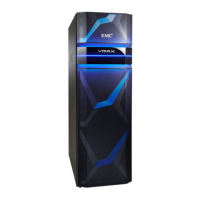In cascaded SRDF/Star configurations with R22 devices:
l
All devices at the production site (Site A) must be configured as concurrent (R11)
devices paired with R21 devices (Site B) and R22 devices (Site C).
l
All devices at the synchronous site in Site B must be configured as R21 devices.
l
All devices at the asynchronous site in Site C must be configured as R22 devices.
Requirements/restrictions
Cascaded and Concurrent SRDF/Star configurations (with and without R22 devices)
require the following:
l
All SRDF/Star device pairs must be of the same geometry and size.
l
All SRDF groups including inactive ones must be defined and operational prior to
entering SRDF/Star mode.
l
It is strongly recommended that all SRDF devices be locally protected and that
each SRDF device is configured with TimeFinder to provide local replicas at each
site.
SRDF four-site solutions for open systems
The four-site SRDF solution for open systems host environments replicates FBA data
by using both concurrent and cascaded SRDF topologies.
Four-site SRDF is a multi-region disaster recovery solution with higher availability,
improved protection, and less downtime than concurrent or cascaded SRDF solutions.
Four-site SRDF solution offers multi-region high availability by combining the benefits
of concurrent and cascaded SRDF solutions.
If two sites fail because of a regional disaster, a copy of the data is available, and you
have protection between the remaining two sites. You can create a four-site SRDF
topology from an existing 2-site or 3-site SRDF topology. Four-site SRDF can also be
used for data migration.
The following image shows an example of the four-site SRDF solution.
Remote replication solutions
SRDF/Star solutions 113

